Princesse Beer (1)
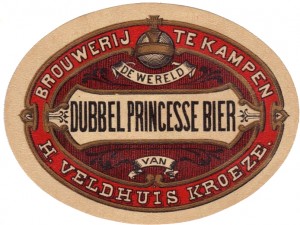 Now let’s talk about one of the most popular Dutch beers of the 19th century: princessebier. Where did this ‘princess beer’ come from, when did it disappear, and what is that funny name about? And of course, is there a recipe? There is, and not only has the renowned Anchor brewery made a one-off reconstruction, it is going to be re-brewed by a once-famous Dutch beer brand as well.
Now let’s talk about one of the most popular Dutch beers of the 19th century: princessebier. Where did this ‘princess beer’ come from, when did it disappear, and what is that funny name about? And of course, is there a recipe? There is, and not only has the renowned Anchor brewery made a one-off reconstruction, it is going to be re-brewed by a once-famous Dutch beer brand as well.
In 1748, a new beer is mentioned in the lists of beers ‘for merchandise’ of the Dutch East India Company. This beer was ‘of the brand Princesse Royal’ and was supplied by Pieter Bolten of the Hooiberg (‘Haystack’) brewery on the Nieuwezijds Voorburgwal in Amsterdam. Like the other beers on the list, it cost 12 guilders per tun.[1] (And incidentally, the Hooiberg brewery was the one where in 1864 Heineken would start its beer empire.)
Princesse beer is therefore a relatively young beer type. The next mention of it dates from 1749, when Amsterdam brewery De Gekroonde Valk (‘The Crowned Falcon’) announced in a newspaper that despite the death of brewer David van den Bosch they would continue to make beer, ‘especially Brewing the Princesse-Beer for East India and other Regions’.[2] In the years 1752-1756 princesse keeps appearing in the Dutch East India Company files. In 1777 it features in Vlissingen among brown, Loender and white beer and in 1788 brewer Antonius Parmentier in Bruges made it known that he was ‘brewing white Dutch Princesse Beers’ like the ones of Amsterdam, Rotterdam and Alkmaar, ‘being a kind of Beers that can be easily transported by Sea without any modification, to the French Isles and to East and West India, known well enough by al Gentlemen Seefarers’.[3] He adds that for sea captains he can brew the brew fresh ‘after degree of passage’, or as strong as needed for the journey.
It appears, therefore, that princesse beer started out as a shipping beer for long distance travel by sea. Like a kind of IPA? That’s where the misunderstandings start. For a start, IPA didn’t exist yet, it would appear as such only in the 19th century. English brewers did however export beer to India since at least 1711 (according to Martyn Cornell’s website Zytophile, a must-read on this subject). This was however mostly porter, because the first pale ale known to reach India only did so in 1784. The English did however know by at least 1760 that beer destined for India had to be extra hopped.
So, was princesse beer more hopped too? There is nothing to indicate that. However, it was indeed sent to the tropics. The oldest preserved newspapers from the Dutch Indies (present-day Indonesia), Suriname and the Dutch Antilles date from around 1810. In these, princesse beer is often mentioned, with a peak in the 1830. In the Netherlands itself however, it was not yet so common: adverts in the 18th century and the first decades of the 19th rather mention brown, white, Luiks and Loender beer, and also faro, lambiek and mol (I’ll get to those later).
By the way, have no illusions: in the Dutch East Indies princesse beer was only one of the beer types. In the first half of the 19th century they imported a lot of English beer there, especially Hodgson’s London pale ale and the beer made by the Burton-upon-Trent brewers that would finally acquire the name India Pale Ale. In the course of the 19th century, Dutch brewers got a bigger grip on the Dutch Indian market, but mostly with Valkbier (beer from the Gekroonde Valk brewery) and Haantjesbier (from De Haan & Sleutels). After 1840, these two Amsterdam breweries seem to have reserved the name princesse beer for the Dutch market.
After being mainly an export beer, in the 19th century princesse beer started to become popular in Holland itself. More and more breweries and traders started mentioning the beer in their adverts, and soon a ‘double’ variant appeared. In 1820 there was a ‘Best double Princesse Royal and Brown Beer’ for sale in Suriname, and in 1832 on Java a ‘light and heavy princesse beer’. Also, in 1833 for the first time there is a ‘best aged’ princesse beer from Zwolle and also elsewhere aged or old princesse was available.[4]
After 1850 it really became a widely spread beer type in the Netherlands. The aforementioned Gekroonde Valk produced it a lot, just like their colleagues at the Haan & Sleutels. In this period, both of these Amsterdam breweries were arguably the biggest in the country, with 50 to 60 employees each, also because of their export to the Dutch Indies. But danger was lurking in the dark: bottom fermentation.
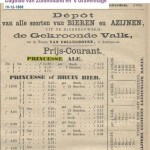 |
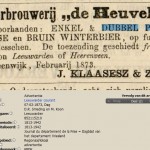 |
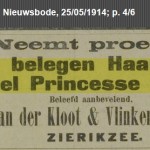 |
After the Koninklijke Nederlandsche Beijersch Bierbrouwerij (Royal Dutch Bavarian Beer Brewery) started production in Amsterdam in 1867, a new way of brewing gained ground in the Netherlands. Because of the capital needed, the bottom-fermenting or ‘Bavarian’ brewing method was much more industrial and large-scale than what the country had seen so far. The result was predictable: in the end, all Dutch top-fermenting beers would disappear. But not before the Gekroonde Valk and others had tried everything to face the competition.
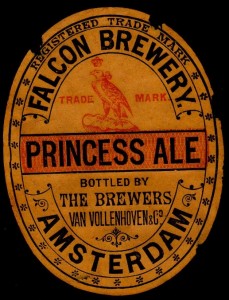 So, in 1868, the year that the German way of brewing really hit it off, the Gekroonde Valk chose to specialise in English styles. That year they introduced ‘Princesse Ale’.[5] Later, they started producing a very successful stout, from 1880 onwards. Interestingly, they tried to sell the two products together: supposedly, their stout was ‘mixed with our Princesse beer, even for children an excellent strengthening drink’. More so, they claimed that mixing stout with bottom-fermented beer was impossible, because ‘it doesn’t unite that well with Stout to form a pleasing whole’.[6]
So, in 1868, the year that the German way of brewing really hit it off, the Gekroonde Valk chose to specialise in English styles. That year they introduced ‘Princesse Ale’.[5] Later, they started producing a very successful stout, from 1880 onwards. Interestingly, they tried to sell the two products together: supposedly, their stout was ‘mixed with our Princesse beer, even for children an excellent strengthening drink’. More so, they claimed that mixing stout with bottom-fermented beer was impossible, because ‘it doesn’t unite that well with Stout to form a pleasing whole’.[6]
It was a lost cause. Even the Gekroonde Valk went along with modern times and opened a bottom-fermented section in 1886. The same year, Princesse Ale was discontinued. Their competitor Haan & Sleutels from 1885 tried a ‘Princesse lager beer’ which didn’t live long.[7] Princesse beer was by now seen as ‘Oud-Hollandsch’ (‘Old Dutch’) and Amsterdam beer bottling agent P.J.A. Chrispijn had to admit in 1889 that ‘lately it has been outcompeted somewhat by the Lager beers’. In the spring of 1895 the Gekroonde Valk put it like this: ‘The old Dutch (Princesse) Beer, that is threatened to pass into oblivion by the many types of Bottom-fermented beers, remains nevertheless an excellent drink… The Gekroonde Valk brewery continues to produce it, trying to maintain its old glory.’[8]
These were idle attempts: after 1900 the princesse beer had disappeared from the market almost entirely. I know of only one brewery that continued to make it after the First World War. Which brewery? And where does the name princesse come from? And of course: is there a recipe? We’ll look at that in the next article.[9]
[1] J. Gawronski, ‘Bier voor de VOC’, in: R.E. Kistemaker en V.T. van Vilsteren (redactie), Bier! Geschiedenis van een volksdrank, Amsterdam 1994, p. 132-149.
[2] Amsterdamse courant 10-4-1749.
[3] Middelburgsche courant 17-5-1777, Gendsche Gazette 1-12-1788.
[4] Surinaamsche courant 10-11-1820, Javasche courant 25-9-1832, Groninger courant 7-5-1833.
[5] Dagblad van Zuidholland en ‘s Gravenhage 10-12-1868.
[6] Folder issued by P.J.A. Chrispijn ca. 1889, Archive Van Vollenhoven at the City Archive Amsterdam.
[7] Het nieuws van den dag 24-8-1885.
[8] Archive Van Vollenhoven at the City Archive Amsterdam.
[9] This article was based on an earlier version in Dutch, http://verlorenbieren.nl/verloren-bieren-49-princessebier-1/.






Thank you for the kind mention – princess beer is also listed on sale in Cape Town in 1806 (Cape Town Gazette, July 19 1806, p2), alongside Porter and Dutch brown beer. (This is about the time the British regained the Cape permanently from the Dutch)
Hi Martyn, thanks for the tip!